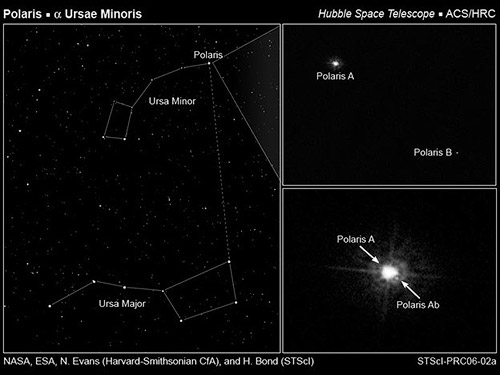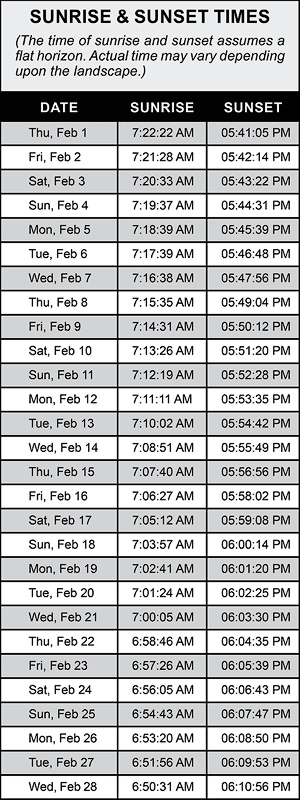|
|
DARK SKY HAPPENINGS - February 2024
Moab
UT (at City Hall)
38O34’ N Latitude
109O33’ W Longitude
4048 ft - 1234 m |
Constant Companions: Circumpolar Constellations, Part I
Adapted from an article by Kat Troche
 |
| The counterclockwise circumpolar constellations Auriga, Cassiopeia, and Ursa Minor are in the night sky, with the Pinwheel Cluster, Starfish Cluster, Owl Cluster, and Polaris circled in yellow.
Credit: Stellarium Web |
Winter in the northern hemisphere offers crisp, clear nights, along with better views of several circumpolar constellations. These constellations that surround the north and south celestial poles never fall below the horizon. Depending on your latitude, you may see up to nine circumpolar constellations in the northern hemisphere. Today, we’ll focus on three that have gems within: Auriga, Cassiopeia, and Ursa Minor.
The counterclockwise circumpolar constellations Auriga, Cassiopeia, and Ursa Minor are in the night sky, with the Pinwheel Cluster, Starfish Cluster, Owl Cluster, and Polaris circled in yellow.
Credit: Stellarium Web
• The Pinwheel Cluster: Located near the edge of Auriga, this open star cluster is easy to spot with a pair of binoculars or small telescope. At just 25 million years old, it contains no red giant stars and looks similar to the Pleiades. To find this, draw a line between the stars Elnath in Taurus and Menkalinan in Auriga. You will also find the Starfish Cluster nearby.
 |
This image from the Hubble Telescope depicts the Polaris star system, showing three stars: Polaris A, Ab, and Polaris B.
Credit: NASA, ESA, N. Evans (Harvard-Smithsonian CfA), and H. Bond (STScI) |
• The Owl Cluster: Located in the ‘W’ or ‘M’ shaped constellation Cassiopeia, is the open star cluster known as the Owl Cluster. Sometimes referred to as the E.T. Cluster or Dragonfly Cluster, this group of stars never sets below the horizon and can be spotted with binoculars or a small telescope.
This image from the Hubble Telescope depicts the Polaris star system, showing three stars: Polaris A, Ab, and Polaris B.
Credit: NASA, ESA, N. Evans (Harvard-Smithsonian CfA), and H. Bond (STScI)
• Polaris: Did you know that Polaris is a triple star system? Look for the North Star on the edge of Ursa Minor, and with a medium-sized telescope, you should be able to separate two of the three stars. Polaris is also known as a Cepheid variable star, meaning that it varies in brightness, temperature, and diameter. It’s the closest one of its kind to Earth, making it a great target for study.
We’ll end with a note about Moab’s own dark skies. The early evenings of winter are also an excellent time to improve lighting, ensuring it illuminates the ground and not the sky. The City of Moab is piloting dark sky retrofits in the decorative fixtures from 200 South to 300 South on Main Street during February. Visit moabcity.org/598/City-Streetlight-Conversion-Project for more information.
Sunrise-Sunset
(The time of sunrise and sunset assumes a flat horizon. Actual time may
vary depending upon the landscape.) |
 |
MOON HAPPENINGS
February 2 - Third Quarter at 4:18 pm February 9 - New Moon at 3:59 pm February 16 - First Quarter at 8:00 am February 24 - Full Moon at 5:30 am
|
Moab Dark Skies mission is to promote the appreciation and conservation of Moab’s valuable and rare dark skies. Moab Dark Skies was established by the Friends of Arches and Canyonlands Parks in conjunction with the National Park Service and Utah State Parks Division of Natural Resources
For more information, check out our
Facebook page |
|
|
|
|
|
|
|
© 2002-2024 Moab Happenings. All rights
reserved.
Reproduction of information contained in this site is
expressly prohibited.
|
|